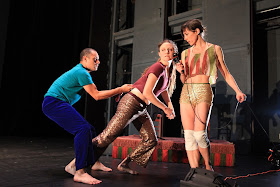 |
| Donald Byrd's Spectrum Dance Theater in The Minstrel Show Revisited Below, l-r: Fausto Rivera, Alex Crozier and Alexis "Tilly" Evans-Krueger (photos: Ian Douglas) |
The black-faced mask of minstrel shows is a lingering image from America's past that still inflicts wounds today through its psychic hold...In the future if we are to be free from its terrible grip we must confront it boldly and courageously by staring back into its face and laughing at the absurdity of its representation until it no longer has the power to hurt us. Only then will it be vanquished and we are free to be. -- Donald ByrdYou might have thought Donald Byrd would bury the tough stuff somewhere down inside The Minstrel Show Revisited and gradually ease you into it. But this dance-theater piece--sourced in Byrd's provocative 1991 Bessie-winner, The Minstrel Show--opens with the problem right before your eyes: a white male dancer singing that classic rag, "A Hot Time in the Old Town," in blackface and Afro wig. It doesn't ease anything when more blackfaced dancers from Byrd's multiracial Spectrum Dance Theater join in--peppy entertainers whose high kicks and high jinks, tumbling and sexy hip-pumping establish a through-line from 19th Century minstrelsy to today's musical theater.
In the program for The Minstrel Show Revisited's run at NYU Skirball Center for the Performing Arts, Byrd reprinted Scott Delahunta's essay for the original production. Delahunta argues that stereotypes are a survival mechanism, making complexity less challenging and reality less threatening. They worked for white Americans faced with an African population they could no longer define and claim as property. They still work, today, for white Americans faced with the looming prospect of no longer being the majority group in this country. And that's just for starters.
Rather than shrink from mindless and noxious stereotyping, Byrd wallows in it for the sake of doing exactly what popular entertainment is not supposed to do--hold a merciless mirror up to the people who have paid to be distracted from problems. "We like to laugh, to cry and not have to 'think too much' and in doing so we become complicitous in the process of stereotyping," Delahunta wrote. Thus the tension in The Minstrel Show Revisited. The choreography and performances are skillful and dynamic. But, if you pay close attention, you become aware of how hollow and shallow the stage picture, for all its activity, looks and feels.
Over the course of the hour, Byrd's dancers not only dance a lot but also line up to tell an alarming number of offensive jokes aimed at a diversity of targets. But reworking 1991 also gives Byrd the chance to open the piece to audience participation, inviting several folks up on stage to tell the last racist joke they heard. (When I saw it, most of his volunteers happened to be youngish people of color.) This strategy encourages the watcher's Inner Performer to come out and play. It's safe, and it's not safe. It's bad...but it's permitted.
How will the volunteers respond to that invitation? How will the rest of us--sitting not so safely in our chairs--respond to what we're about to hear? It's complicated!
How quickly the volunteers learned just the right intonations and body language for their brief interaction with Byrd. How easily they remembered and told their jokes.
OMG! Look at all these people running around with offensive jokes in their heads! And what was the last offensive joke I heard?
We giggled some because the tellers were cute and brave, and we knew they didn't mean what they said. It felt okay--sort of. That is, until the final and truly cringe-making one, which--whoa!--brought everybody up short.
And even then Byrd wasn't finished with us. He looked out over the house and urged people in the seats to write down a stereotypical joke to be collected and used later. Since I did not stay for the post-show Q&A--the theater seemed unusually tardy in getting it started--I can't say how that worked out.
In his pre-show talk, Awam Amkpa (NYU Associate Professor of Social and Cultural Analysis) noted, "Art does not just reflect culture; it makes it." Byrd accepts his responsibility, as artist and entertainer, to highlight how the arts have served to deliver, spotlight and perpetuate stereotypes, making them not only useful but seductive and addictive. His work work offers no solution but a tap on the shoulder: Now, your turn.
Closed.
For more information on Donald Byrd's Spectrum Dance Theater, click here.
For information on upcoming events at NYU Skirball Center for the Performing Arts, click here.






















